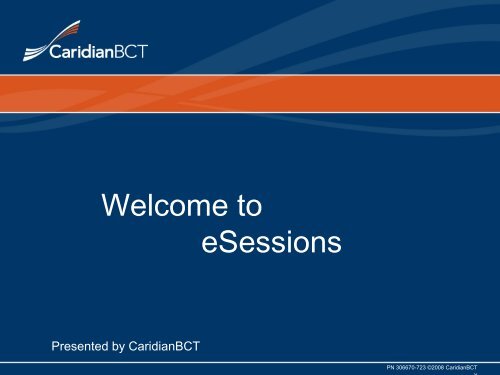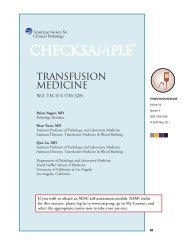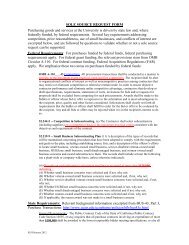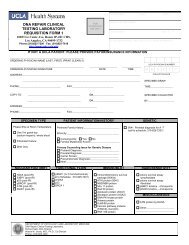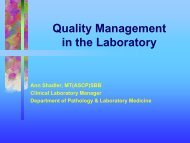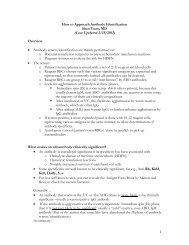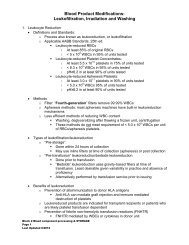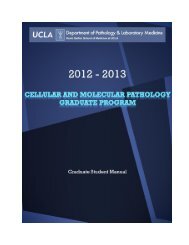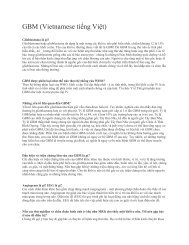RBC Exchange and Depletion Procedures - the UCLA Department ...
RBC Exchange and Depletion Procedures - the UCLA Department ...
RBC Exchange and Depletion Procedures - the UCLA Department ...
- No tags were found...
You also want an ePaper? Increase the reach of your titles
YUMPU automatically turns print PDFs into web optimized ePapers that Google loves.
Welcome toeSessionsPresented by CaridianBCTPN 306670-723 ©2008 CaridianBCT
Red Blood Cell <strong>Exchange</strong><strong>and</strong> <strong>Depletion</strong> <strong>Procedures</strong>COBE Spectra ® Apheresis SystemPN 306670-723 ©2008 CaridianBCT
Red Blood Cell<strong>Exchange</strong> (<strong>RBC</strong>X) <strong>Procedures</strong>PN 306670-723 ©2008 CaridianBCT
Presentation Overview• Indications <strong>and</strong> procedure goals for <strong>RBC</strong>Xprocedures• Overview of operational principles <strong>and</strong>data entry• Unique features of <strong>RBC</strong>X procedures• Helpful hintsPN 306670-723 ©2008 CaridianBCT
Presentation ObjectivesParticipants will be able to• Name two indications for <strong>RBC</strong>X procedures.• List two procedure goals of <strong>RBC</strong>X procedures.• Identify four procedure variables that would prevent<strong>the</strong> expected outcome of <strong>the</strong> procedure.PN 306670-723 ©2008 CaridianBCT
Indications for <strong>RBC</strong>X• Sickle cell disease• Thalassemia• Protozoal infections of red blood cells (<strong>RBC</strong>s)• Incompatible transfusion• Carbon monoxide poisoningPN 306670-723 ©2008 CaridianBCT
Sickle Cell Disease (SCD)• Inherited, chronic disease resulting from <strong>the</strong>production of abnormal hemoglobin S (HbS).- May be homozygous SS (HbSS) or in combination withHbC (HbSC), or with beta thalassemia (HbS Beta).• Most common inherited hematologic disorder.Increased prevalence in African, Mediterranean <strong>and</strong>Indian populations.PN 306670-723 ©2008 CaridianBCT
Sickle Cell Disease (cont)• Under certain conditions, cells containing HbSbecome sickle shaped <strong>and</strong> rigid. They increaseblood viscosity <strong>and</strong> lodge in small vessels,resulting in tissue ischemia <strong>and</strong> painful crises.• Sickle cells have a shortened survival time,approximately 7 to 20 days, which results inaccelerated hemolysis of <strong>RBC</strong>s <strong>and</strong> chronicanemia.PN 306670-723 ©2008 CaridianBCT
Thalassemia• Group of inherited disorders caused bymutations in one or more of <strong>the</strong> genes thatcode for globin proteins which are part of <strong>the</strong>hemoglobin molecule.• Result in a deficiency of alpha or beta globinchains, causing reduced production orabsence of HbA.• Prevalent in <strong>the</strong> Mediterranean basin through<strong>the</strong> Middle East, <strong>and</strong> India to Sou<strong>the</strong>ast Asia.PN 306670-723 ©2008 CaridianBCT
HemoglobinAlpha chainBeta chain= Iron molecule= 2, 3-DPGAlpha chain= Oxygen= Carbon dioxideBeta chainPN 306670-723 ©2008 CaridianBCT
Role of <strong>RBC</strong>X in Hemoglobinopathies• Replace abnormal patient <strong>RBC</strong>s with normal donor<strong>RBC</strong>s to improve oxygen delivery <strong>and</strong> clinicalcondition more efficiently than simple transfusions.• Maintain <strong>the</strong> patient’s hematocrit (Hct) at anappropriate level.• Prevent or decrease iron overload associated wi<strong>the</strong>i<strong>the</strong>r <strong>the</strong> disease process or <strong>the</strong> use of simpletransfusion.PN 306670-723 ©2008 CaridianBCT
Protozoal Infections• Malaria- Mosquito-borne illness caused by infection of <strong>RBC</strong>swith Plasmodium protozoa.- Symptoms include:• Fever• Chills• Headache• AnemiaPN 306670-723 ©2008 CaridianBCT
Protozoal Infections (cont)• Babesiosis- Tick-borne, malaria-like illness caused byinfection of <strong>RBC</strong>s with Babesia protozoa.- Symptoms relate to <strong>the</strong> degree of parasiticload <strong>and</strong> include:• Fever• Hemolytic anemia• HemoglobinuriaPN 306670-723 ©2008 CaridianBCT
Role of <strong>RBC</strong>X in Protozoal Infections<strong>RBC</strong>X can be used adjunctively to reduce highparasitic loads observed with protozoal infections,especially with P. falciparum.PN 306670-723 ©2008 CaridianBCT
O<strong>the</strong>r Indications• Incompatible <strong>RBC</strong> transfusion- Removal of Rh-positive cells fromRh-negative recipient.- Removal of ABO-incompatible <strong>RBC</strong>s post-transplantor post-transfusion.• Carbon monoxide poisoning- Competition between carbon monoxide (CO) <strong>and</strong>oxygen for binding sites on hemoglobin.- Removal of CO-saturated <strong>RBC</strong>s.PN 306670-723 ©2008 CaridianBCT
Spectra System <strong>RBC</strong>X Procedure Goals• Reduce <strong>the</strong> number of defective or infected<strong>RBC</strong>s <strong>and</strong> replace <strong>the</strong>m with <strong>the</strong> appropriateamount of replacement <strong>RBC</strong>s.• Maintain or alter <strong>the</strong> patient’s (Hct).• Control fluid balance.PN 306670-723 ©2008 CaridianBCT
Overview ofOperational PrinciplesPN 306670-723 ©2008 CaridianBCT
Fluid PathwayDonor<strong>RBC</strong>sPatient<strong>RBC</strong>sACD-APN 306670-723 ©2008 CaridianBCT
<strong>RBC</strong> Single-Stage Channel Separation<strong>RBC</strong>, WBC &Platelet outPlasmareturnedWhole Blood InPN 306670-723 ©2008 CaridianBCT
Data Entry• Sex, height, weight• Patient’s Hct• Average replacement fluid Hct• Desired end Hct for <strong>the</strong> patient• Fluid balancePN 306670-723 ©2008 CaridianBCT
Data Entry (cont)Patient Hct= 22 %, End Hct= 30 %Average replace Hct= 55 % OK(YES/NO)?The Spectra system uses <strong>the</strong> Hct values you enterto calculate <strong>the</strong> pre- <strong>and</strong> post-procedure red cellvolume of <strong>the</strong> patient, <strong>and</strong> <strong>the</strong> red cell volume of<strong>the</strong> replacement fluid.The system <strong>the</strong>n uses <strong>the</strong>se red cell volumes todetermine <strong>the</strong> volume of replacement fluidrequired to achieve <strong>the</strong> desired end results.PN 306670-723 ©2008 CaridianBCT
Replacement Fluid Volume CalculationAfter you enter <strong>the</strong> initial data, <strong>the</strong> followingscreen appears:Calculate replacement fluid volumeneeded. (YES/NO)?To let <strong>the</strong> Spectra system calculate <strong>the</strong> requiredreplacement volume, press YES.PN 306670-723 ©2008 CaridianBCT
Replacement Fluid Volume Calculation (cont)Enter <strong>the</strong> desired fraction of red cells remaining (FCR).The default FCR is 40%.Enter desired Fraction of red cellsremaining: FCR = {40}% (YES/NO)?PN 306670-723 ©2008 CaridianBCT
What is FCR?FCR is <strong>the</strong> percentage of <strong>the</strong> patient’s original <strong>RBC</strong>sremaining in <strong>the</strong> patient at <strong>the</strong> end of <strong>the</strong> procedure.100%patient HbS <strong>RBC</strong><strong>RBC</strong>X80%donor HbA <strong>RBC</strong>20% patient HbS <strong>RBC</strong> = FCR%PN 306670-723 ©2008 CaridianBCT
Using <strong>the</strong> FCRDonor<strong>RBC</strong>/HbA(50%)HbAPatient<strong>RBC</strong>/HbS(50%)<strong>RBC</strong>X20% HbSFCR40%PN 306670-723 ©2008 CaridianBCT
Using <strong>the</strong> FCR to Meet HbS GoalsDesired end HbS conc----------------------------- x 100 = FCRStarting HbS concExample:Desired end HbS = 20%Starting HbS = 50%20--- x 100 = 40%50 During data entry, enter 40% as <strong>the</strong> desired FCR.PN 306670-723 ©2008 CaridianBCT
Replacement Fluid Volume CalculationEnter <strong>the</strong> desired FCR:Enter desired Fraction of red cellsremaining: FCR = {20}%The Spectra system calculates <strong>and</strong> displays<strong>the</strong> run results:Replace= 3398ml, FB= 100%, FCR= 20%,End Hct= 30%, time= 151 min (YES/N0)?PN 306670-723 ©2008 CaridianBCT
Replacement Fluid Volume Calculation (cont)Changing <strong>the</strong> FCR changes <strong>the</strong> replacement fluidvolume required.Example:Enter desired Fraction of red cellsremaining: FCR = {40}%Replace= 1934 ml, FB=100%, FCR= 40%,End Hct= 30%, time= 87 min OK(YES/N0)?PN 306670-723 ©2008 CaridianBCT
Replacement Fluid Volume Calculation (cont)Two options are available for calculating requiredreplacement fluid volume prior to <strong>the</strong> procedure:•Spectra system calculation.•“Replacement Volume Estimation Tool for <strong>RBC</strong> <strong>Exchange</strong><strong>Procedures</strong>” (available at www.caridianbct.com).PN 306670-723 ©2008 CaridianBCT
Replacement Fluid Volume Estimation ToolPN 306670-723 ©2008 CaridianBCT
Replacement Fluid Volume• Replacement fluid volume can bedetermined by- Value from <strong>the</strong> calculation tool or from<strong>the</strong> Spectra system- Physician’s order- Volume <strong>the</strong> blood bank has availablePN 306670-723 ©2008 CaridianBCT
Replacement Fluid Volume EntryOnce you enter <strong>the</strong> initial data, <strong>the</strong> following screenappears:Calculate replacement fluid volumeneeded (YES/NO)?To enter a specific replacement fluid volume, pressNO. The Spectra system <strong>the</strong>n prompts you to enter<strong>the</strong> replacement fluid volume:Enter total replacement fluid volume:{ 0} ml.PN 306670-723 ©2008 CaridianBCT
Replacement Fluid Volume Entry (cont)Enter <strong>the</strong> available replacement fluid volume:Enter total replacement fluid volume:{1500}ml.The Spectra system calculates <strong>and</strong> displays <strong>the</strong>run results:Replace=1500 ml, FB=100%, FCR= 48%,End Hct= 30%, time= 68 min OK(YES/N0)?PN 306670-723 ©2008 CaridianBCT
Data Influencing Predicted Run ResultsPredictedrunresultsPN 306670-723 ©2008 CaridianBCT
Unique Features of<strong>RBC</strong>X <strong>Procedures</strong>PN 306670-723 ©2008 CaridianBCT
AC Infusion RateO.9 mL/min/L TBV• AC data screen is unavailable during <strong>the</strong> procedure.• The default AC infusion rate is 0.9 mL/min/L TBV.• AC infusion rate alarm limit is 1.4 mL/min/L TBV.• The citrate in <strong>the</strong> replacement fluid is not considered.PN 306670-723 ©2008 CaridianBCT
AC Volume Calculation ToolINPUT DATAAC VOL TO PATIENTTBV (ml) AC Volume (ml) NAReplace Volume (ml)Starting Hct (%)AC VOL TO WASTE BAGEnd Hct (%) AC Volume (ml) NAReplace Hct (%)FCR (%)Fluid Balance (%)AC RatioClick Here ForInstructions ForUseAC VOL TO PATIENTINPUT DATATBV (ml) 5000 AC Volume (ml) 213Replace Volume (ml) 2210Starting Hct (%) 28AC VOL TO WASTE BAGEnd Hct (%) 30 AC Volume (ml) 140Replace Hct (%) 60FCR (%) 40Click Here ToFluid Balance (%) 100Return To ACAC Ratio 13CalculationsClick Here ToReview ExampleThis calculation tool helps to estimate <strong>the</strong> ACvolume delivered from <strong>the</strong> AC bag to <strong>the</strong> patient<strong>and</strong> to <strong>the</strong> waste bag during an <strong>RBC</strong>X ordepletion procedure.PN 306670-723 ©2008 CaridianBCT
RinsebackRinseback is notrecommended, because<strong>the</strong> prediction for endHct <strong>and</strong> FCR does notconsider <strong>the</strong> rinsebackvolume.Rinseback(345)End (+345)End (+245)Start: (0)Run (blood prime)Divert(100)Run(-100)Rinseback(345)PN 306670-723 ©2008 CaridianBCT
Helpful Hints• Enter accurate patient Hct. This is a MUST!• Know <strong>the</strong> Hct <strong>and</strong> volume of each unit ofreplacement <strong>RBC</strong>s.• If <strong>the</strong> <strong>RBC</strong> units contain Adsol solution, a spunHct will be inaccurate.• For sickle cell patients, screen <strong>the</strong> replacement<strong>RBC</strong> units for sickle cell trait.• Be aware that platelet <strong>and</strong> WBC counts c<strong>and</strong>ecrease 30% to 50%.PN 306670-723 ©2008 CaridianBCT
Helpful Hints (cont)• Consider leukoreducing replacement <strong>RBC</strong> unitsprior to <strong>the</strong> procedure.• Entering a combination of values that approachupper <strong>and</strong>/or lower extremes will result in invalidprocess time or replacement fluid volumealarms.• Target time can be changed only by changing<strong>the</strong> collect/replace volume.• After <strong>the</strong> “divert prime operation,” changes toreplacement fluid Hct are invalid.PN 306670-723 ©2008 CaridianBCT
Red Blood Cell (<strong>RBC</strong>)<strong>Depletion</strong> <strong>Procedures</strong>PN 306670-723 ©2008 CaridianBCT
Presentation Overview• Indications for <strong>RBC</strong> depletion procedures• Procedure goals for <strong>RBC</strong> depletion procedures• Data entryPN 306670-723 ©2008 CaridianBCT
Presentation ObjectivesParticipants will be able to• List one indication for an <strong>RBC</strong> depletion procedure.• Identify one <strong>RBC</strong> depletion procedure goal.• Name <strong>the</strong> data entry value that causes <strong>the</strong> Spectrasystem to perform an <strong>RBC</strong> depletion procedure.PN 306670-723 ©2008 CaridianBCT
Indications for <strong>RBC</strong> <strong>Depletion</strong>• Polycy<strong>the</strong>mia vera• Iron overload- Primary hemochromatosis- Secondary hemochromatosis• Iron-loading anemia• Chronic transfusionPN 306670-723 ©2008 CaridianBCT
Polycy<strong>the</strong>mia Vera• Myeloproliferative disorder characterized byuncontrolled production of normal <strong>RBC</strong>s,granulocytes, <strong>and</strong> platelets, resulting in Hcts ashigh as 80%.• Major symptoms result from an increase in <strong>RBC</strong>mass <strong>and</strong> blood viscosity. Symptoms include:- Increased blood pressure- Headache- Visual disturbancesPN 306670-723 ©2008 CaridianBCT
Hemochromatosis• Primary hemochromatosis is a genetic disorderthat interferes with iron metabolism. It results inexcess iron being deposited in organs <strong>and</strong> tissue.• Secondary hemochromatosis can result fromiron-loading anemias such as thalassemia, orfrom chronic transfusion.PN 306670-723 ©2008 CaridianBCT
Procedure Goals• Rapid removal of greatly elevated numbers of<strong>RBC</strong>s to reduce blood viscosity <strong>and</strong> red cellvolume, or removal of <strong>RBC</strong>s to reduce iron load<strong>and</strong> maintain normal iron levels.• Control of <strong>the</strong> fluid balance by replacementof removed volume with appropriate fluids.PN 306670-723 ©2008 CaridianBCT
<strong>RBC</strong> <strong>Depletion</strong> vs. PhlebotomyAutomated <strong>RBC</strong> depletion can remove largervolumes of <strong>RBC</strong>s than manual phlebotomy can, <strong>and</strong>allows volume replacement with appropriate fluids.PN 306670-723 ©2008 CaridianBCT
Data Entry• Sex, height, weight• Patient’s Hct• Average replacement fluid Hct Enter 0%• Desired end Hct for <strong>the</strong> patient• Fluid balancePN 306670-723 ©2008 CaridianBCT
Data Entry (cont)1. Verify <strong>the</strong> entered Hcts:Patient Hct= 65 %, End Hct= 45 %Average replace Hct= 0 %. OK(YES/N0)?2. Once you enter <strong>the</strong> initial data, <strong>the</strong> following screen appears:Calculate replacement fluidneeded (YES/NO)?3. To let <strong>the</strong> Spectra system calculate <strong>and</strong> display <strong>the</strong> runresults, press YES:Replace=1360 ml, FB=100%, FCR= 100%,End Hct= 45%, time= 36 min OK(YES/N0)?PN 306670-723 ©2008 CaridianBCT
References1. Altman, A.J., “Polycy<strong>the</strong>mia Vera,” eMedicine,October 31, 2002,(September 20, 2005).2. Cunha, B.A., “Babesiosis,” eMedicine, August 26,2002, (September 20, 2005).3. Hassett, A.C. <strong>and</strong> Kiss, J.E., “HereditaryHemochromatosis,” Transfusion Medicine Update,The Institute for Transfusion Medicine, August1997.PN 306670-723 ©2008 CaridianBCT
References (cont)4. McCleod, B.C. “Introduction to <strong>the</strong> Third SpecialIssue: Clinical Applications of TherapeuticApheresis,” Special Issue: Clinical Applications ofTherapeutic Apheresis, Journal of ClinicalApheresis, Vol. 15, No. 1/2, 2000.5. Mehta, P.N., “Malaria.” eMedicine, June 23, 2004,(September 20, 2005).6. “Special Issue: Clinical Applications ofTherapeutic Hemapheresis,” Journal of ClinicalApheresis, Vol. 8, No. 4, 1993.PN 306670-723 ©2008 CaridianBCT
References (cont)7. Takeshita, K., “Thalassemia, Beta,” eMedicine,February 20, 2002,(September 20, 2005).8. “Thalassemia,” Dr. Joseph F. Smith MedicalLibrary, Copyright 1999-2001.(September 20, 2005).PN 306670-723 ©2008 CaridianBCT


